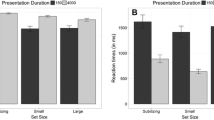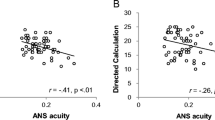Abstract
Whether our general numerical skills and the mathematical knowledge that we acquire at school are entwined is a debated issue, which many researchers are still striving to investigate. The findings reported in the literature are actually inconsistent; some studies emphasized the existence of a relationship between the acuity of the Approximate Number System (ANS) and arithmetic competence, while some others did not observe any significant correlation. One potential explanation of the discrepancy might stem from the evaluation of the ANS itself. In the present study, we correlated two measures used to index ANS acuity with arithmetic performance. These measures were the Weber fraction (w), computed from a numerical comparison task and the coefficient of variation (CV), computed from a numerical estimation task. Arithmetic performance correlated with estimation CV but not with comparison w. We further investigated the meaning of this result by taking the relationship between w and CV into account. We expected a tight relation as both these measures are believed to assess ANS acuity. Crucially, however, w and CV did not correlate with each other. Moreover, the value of w was modulated by the congruity of the relation between numerical magnitude and non-numerical visual cues, potentially accounting for the lack of correlation between the measures. Our findings thus challenge the overuse of w to assess ANS acuity and more generally put into question the relevance of correlating this measure with arithmetic without any deeper understanding of what they are really indexing.



Similar content being viewed by others
Notes
Although the coefficient of variation evaluates the variability (or consistency) of numerical estimates, it does not measure their veridicity, that is, their accuracy with regard to the actual true magnitude
The following mathematical expression was used to fit individual proportion correct responses as a function of ratios (r). The parameter w in the equation is the Weber Fraction.
$$1 - \frac{1}{2}erfc\left[ {\frac{1}{w}\sqrt {\frac{{\left( {r - 1} \right)^{2} }}{{2\left( {r^{2} + 1} \right)}}} } \right]$$Spearman rho coefficients were preferred due to the positive skewness of some of the measures.
The inclusion or the exclusion of two potential outliers did not change the pattern and interpretation of the results
It should be noted that we assessed arithmetic performance—which is highly related to math ability—through one measure of arithmetic fluency. Further studies should investigate whether other aspects of general math ability (such as problem solving, spatial reasoning, etc.) are related to basic numerical abilities, and whether they are validly assessed
References
Barth, H., La Mont, K., Lipton, J., Dehaene, S., Kanwisher, N., & Spelke, E. (2006). Non-symbolic arithmetic in adults and young children. Cognition, 98(3), 199–222.
Brainard, D. H. (1997). The Psychophysics toolbox. Spatial Vision, 10(4), 433–436.
Brannon, E. M. (2006). The representation of numerical magnitude. Current Opinion in Neurobiology, 16, 222–229.
Castronovo, J., & Göbel, S. M. (2012). Impact of high mathematics education on the number sense. PLoS One, 7(4), e33832.
Church, R. M., & Broadbent, H. A. (1990). Alternative representations of time, number, and rate. Cognition, 37(1), 55–81.
Crollen, V., Castronovo, J., & Seron, X. (2011). Under- and over-estimation. Experimental Psychology, 58(1), 39–49.
De Smedt, B., Noël, M.-P., Gilmore, C., & Ansari, D. (2013). How do symbolic and non-symbolic numerical magnitude processing skills relate to individual differences in children’s mathematical skills? A review of evidence from brain and behavior. Trends in Neuroscience and Education, 2(2), 48–55.
De Vos, T. (1992). Test voor het vaststellen van het rekenvaardigheidsniveau der elementaire bewerkingen (automatisering) voor het basis en voortgezet onderwijs: Handleiding [Test to determine the mathematics ability level for elementary operations (automatization) in primary and secondary education: Manual]. Nijmegen, The Netherlands: Berkhout.
Dehaene, S. (2001). Précis of the number sense. Mind and Language, 16(1), 16–36.
Dehaene, S. (2003). The neural basis of the Weber-Fechner law: a logarithmic mental number line. Trends in Cognitive Sciences, 7(4), 145–147.
DeWind, N. K., & Brannon, E. M. (2012). Malleability of the Approximate Number System: effects of feedback and training. Frontiers in Human Neuroscience, 6(68), 1–10.
Frank, M. C., Fedorenko, E., Lai, P., Saxe, R., & Gibson, E. (2012). Verbal interference suppresses exact numerical representation. Cognitive Psychology, 64(1–2), 74–92.
Gebuis, T., Gevers, W., & Cohen Kadosh, R. (2014). Topographic representation of high-level cognition: numerosity or sensory processing? Trends in Cognitive Sciences, 18(1), 1–3.
Gebuis, T., & Reynvoet, B. (2011). Generating nonsymbolic number stimuli. Behavior Research Methods, 43(4), 981–986.
Gebuis, T., & Reynvoet, B. (2012a). The role of visual information in numerosity estimation. PLoS One, 7(5), e37426.
Gebuis, T., & Reynvoet, B. (2012b). Continuous visual properties explain neural responses to nonsymbolic number. Psychophysiology, 49(11), 1649–1659.
Gebuis, T., & Reynvoet, B. (2012c). The interplay between nonsymbolic number and its continuous visual properties. Journal of Experimental Psychology: General, 141(4), 642–648.
Gilmore, C., Attridge, N., Clayton, S., Cragg, L., Johnson, S., Marlow, N., & Inglis, M. (2013). Individual differences in inhibitory control, not non-verbal number acuity, correlate with mathematics achievement. PLoS One, 8(6), e67374.
Gilmore, C. K., Attridge, N., & Inglis, M. (2011). Measuring the approximate number system. The Quarterly Journal of Experimental Psychology, 64(11), 2099–2109.
Gilmore, C. K., McCarthy, S. E., & Spelke, E. S. (2007). Symbolic arithmetic knowledge without instruction. Nature, 447(7144), 589–591.
Guillaume, M., Nys, J., Mussolin, C., & Content, A. (2013). Differences in the acuity of the approximate number system in adults: the effect of mathematical ability. Acta Psychologica, 144(3), 506–512.
Halberda, J., & Feigenson, L. (2008). Developmental change in the acuity of the “number sense”: the approximate number system in 3-, 4-, 5-, and 6-year-olds and adults. Developmental Psychology, 44(5), 1457–1465.
Halberda, J., Ly, R., Wilmer, J. B., Naiman, D. Q., & Germine, L. (2012). Number sense across the lifespan as revealed by a massive Internet-based sample. Proceedings of the National Academy of Sciences of the United States of America, 109(28), 11116–11120.
Halberda, J., Mazzocco, M. M. M., & Feigenson, L. (2008). Individual differences in non-verbal number acuity correlate with maths achievement. Nature, 455(7213), 665–668.
Holloway, I. D., & Ansari, D. (2009). Mapping numerical magnitudes onto symbols: the numerical distance effect and individual differences in children’s mathematics achievement. Journal of Experimental Child Psychology, 103(1), 17–29.
Inglis, M., Attridge, N., Batchelor, S., & Gilmore, C. (2011). Non-verbal number acuity correlates with symbolic mathematics achievement: but only in children. Psychonomic Bulletin and Review, 18, 1222–1229.
Inglis, M., & Gilmore, C. (2013). Sampling from the mental number line: how are approximate number system representations formed? Cognition, 129(1), 63–69.
Izard, V., & Dehaene, S. (2008). Calibrating the mental number line. Cognition, 106(3), 1221–1247.
Kleiner, M., Brainard, D. H., & Pelli, D. G. (2007). What’s new in Psychtoolbox-3? Perception, 36 ECVP Abstract Supplement.
Libertus, M. E., Feigenson, L., & Halberda, J. (2011). Preschool acuity of the approximate number system correlates with school math ability. Developmental Science, 14(6), 1292–1300.
Libertus, M. E., Odic, D., & Halberda, J. (2012). Intuitive sense of number correlates with math scores on college-entrance examination. Acta Psychologica, 141(3), 373–379.
Lyons, I. M., & Beilock, S. L. (2011). Numerical ordering ability mediates the relation between number-sense and arithmetic competence. Cognition, 121(2), 256–261.
Lyons, I. M., Price, G. R., Vaessen, A., Blomert, L., & Ansari, D. (2014). Numerical predictors of arithmetic success in grades 1–6. Developmental Science,. doi:10.1111/desc.12152.
Macizo, P., & Herrera, A. (2011). Cognitive control in number processing: evidence from the unit–decade compatibility effect. Acta Psychologica, 136(1), 112–118.
Meck, W. H., & Church, R. M. (1983). A mode control model of counting and timing processes. Journal of Experimental Psychology: Animal Behavior Processes, 9(3), 320.
Mejias, S., Grégoire, J., & Noël, M.-P. (2012a). Numerical estimation in adults with and without developmental dyscalculia. Learning and Individual Differences, 22(1), 164–170.
Mejias, S., Mussolin, C., Rousselle, L., Grégoire, J., & Noël, M.-P. (2012b). Numerical and nonnumerical estimation in children with and without mathematical learning disabilities. Child Neuropsychology, 18(6), 550–575.
Mejias, S., & Schiltz, C. (2013). Estimation abilities of large numerosities in Kindergartners. Frontiers in Psychology,. doi:10.3389/fpsyg.2013.00518.
Nuerk, H.-C., Weger, U., & Willmes, K. (2001). Decade breaks in the mental number line? Putting the tens and units back in different bins. Cognition, 82(1), 25–33.
Nys, J., & Content, A. (2012). Judgement of discrete and continuous quantity in adults: number counts! The Quarterly Journal of Experimental Psychology, 65(4), 675–690.
Nys, J., Ventura, P., Fernandes, T., Querido, L., Leybaert, J., & Content, A. (2013). Does math education modify the approximate number system? A comparison of schooled and unschooled adults. Trends in Neuroscience and Education, 2(1), 13–22.
Piazza, M., Izard, V., Pinel, P., Le Bihan, D., & Dehaene, S. (2004). Tuning curves for approximate numerosity in the human intraparietal sulcus. Neuron, 44(3), 547–555.
Pica, P., Lemer, C., Izard, V., & Dehaene, S. (2004). Exact and approximate arithmetic in an Amazonian indigene group. Science, 306(5695), 499–503.
Platt, J. R., & Johnson, D. M. (1971). Localization of position within a homogeneous behavior chain: effects of error contingencies. Learning and Motivation, 2(4), 386–414.
Price, G. R., Palmer, D., Battista, C., & Ansari, D. (2012). Nonsymbolic numerical magnitude comparison: reliability and validity of different task variants and outcome measures, and their relationship to arithmetic achievement in adults. Acta Psychologica, 140, 50–57.
Ramos-Christian, V., Schleser, R., & Varn, M. E. (2008). Math fluency: accuracy versus speed in preoperational and concrete operational first and second grade children. Early Childhood Education Journal, 35(6), 543–549.
Sasanguie, D., De Smedt, B., Defever, E., & Reynvoet, B. (2011). Association between basic numerical abilities and mathematics achievement. British Journal of Developmental Psychology, 30(2), 344–357.
Sasanguie, D., Göbel, S. M., Moll, K., Smets, K., & Reynvoet, B. (2013). Approximate number sense, symbolic number processing, or number–space mappings: what underlies mathematics achievement? Journal of Experimental Child Psychology, 114(3), 418–431.
Smets, K., Gebuis, T., Defever, E., & Reynvoet, B. (2014). Concurrent validity of approximate number sense tasks in adults and children. Acta Psychologica, 150, 120–128.
Smets, K., Sasanguie, D., Szücs, D., & Reynvoet, B. (2015). The effect of different methods to construct non-symbolic stimuli in numerosity estimation and comparison. Journal of Cognitive Psychology,. doi:10.1080/20445911.2014.996568.
Sullivan, J., & Barner, D. (2013). How are number words mapped to approximate magnitudes? The Quarterly Journal of Experimental Psychology, 66(2), 389–402.
Sullivan, J., & Barner, D. (2014). Inference and association in children’s early numerical estimation. Child Development,. doi:10.1111/cdev.12211.
Whalen, J., Gallistel, C. R., & Gelman, R. (1999). Nonverbal counting in humans: the psychophysics of number representation. Psychological Science, 10(2), 130–137.
Acknowledgments
Mathieu Guillaume was supported by a grant from the Belgian Fund for Scientific Research (FRS-FNRS, Belgium). The authors declare no conflict of interest that might be interpreted as influencing the research, and APA ethical standards were followed in the conduct of the study. Authors gratefully thank all the participants for their collaboration with the study. Correspondence and requests for materials should be addressed to Mathieu Guillaume (maguilla@ulb.ac.be).
Author information
Authors and Affiliations
Corresponding author
Rights and permissions
About this article
Cite this article
Guillaume, M., Gevers, W. & Content, A. Assessing the Approximate Number System: no relation between numerical comparison and estimation tasks. Psychological Research 80, 248–258 (2016). https://doi.org/10.1007/s00426-015-0657-x
Received:
Accepted:
Published:
Issue Date:
DOI: https://doi.org/10.1007/s00426-015-0657-x




